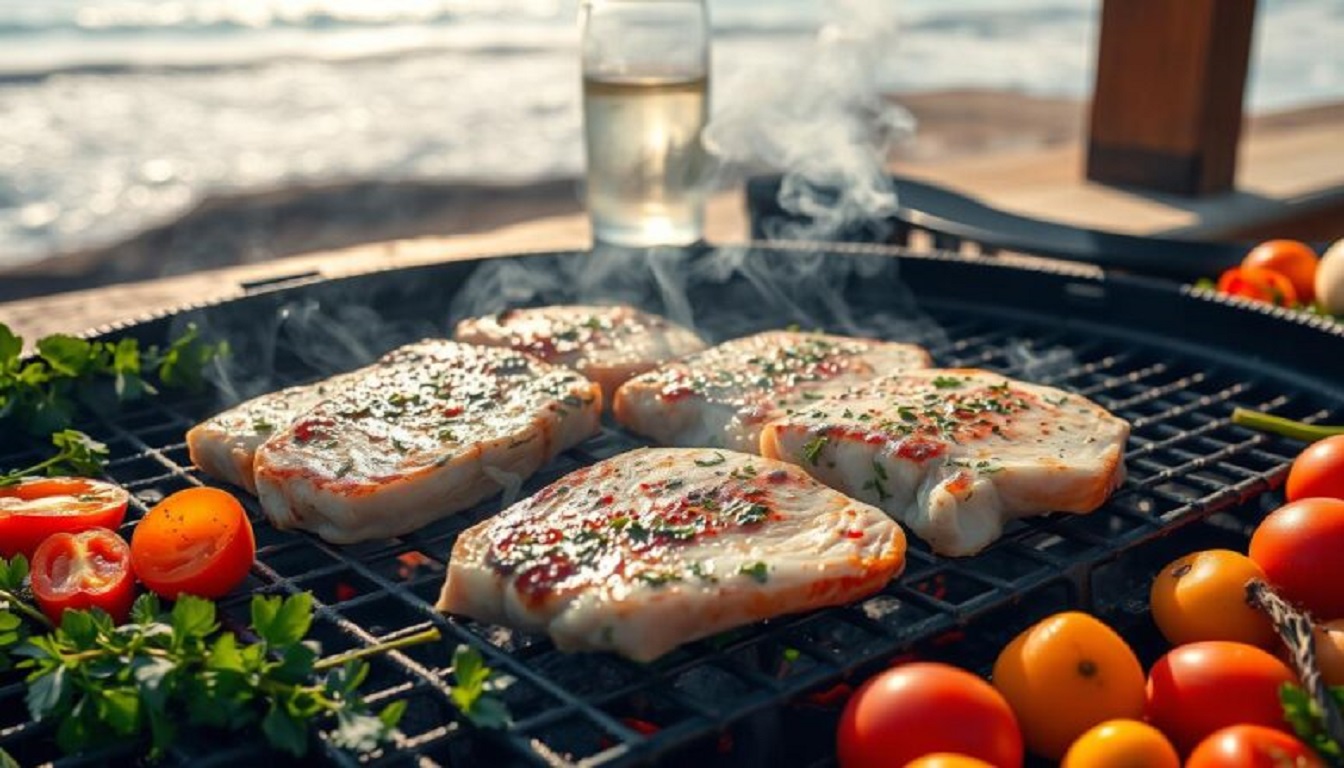Mastering Swordfish Steaks Easy Cooking Guide
Have you ever wondered why swordfish steaks often go unconsidered when grilling seafood? Despite their juicy and tasty nature, people often overlook them. If you grill these on the grill, in the oven, or pan-sear, they can transform the way you cook. This guide will show you how to cook swordfish steaks, an instant hit for any meal.
This course will cover everything from securing the best swordfish available to experimenting with delicious swordfish recipes. At the end of the course, you’ll be the most popular chef to cook meals that everyone will appreciate!
Table of Contents
Key Takeaways
- Learn how to select the best swordfish for maximum flavor.
- Learn the essential cleaning techniques and how to cook barbeque steaks from swordfish.
- Learn about various cooking methods, such as grilling and baking.
- Explore the variety of flavorful spices to spice up your meal.
- Be creative when serving ideas and other side dishes.
Selecting the Perfect Swordfish
The right swordfish to choose from is essential to a satisfying dinner. To ensure that the swordfish you choose tastes great and is of good quality, find certain indicators. Here are some suggestions for selecting fresh swordfish.
Freshness Indicators
When you are catching swordfish, look for signs of freshness. The flesh should be solid, humid, and look lively. There should be a light, sweet scent. A fishy scent means that the fish isn’t fresh. The most effective swordfish smells like the ocean.
Quality Checks
The swordfish’s color is critical to its quality. You should look for a pinkish hue without discoloration. It should be soft, but still firm enough to bite. To ensure better quality and help the environment, choose sustainably sourced swordfish.
Preparing Your Swordfish Steaks
Understanding how to cook swordfish steaks starts with proper preparation. It is essential to highlight the rich flavor of the fish. Start by thoroughly washing and drying the fish, which are essential for successful cooking.
Cleaning and drying techniques
Before washing the swordfish steaks, rinse them under cool water for a few minutes. This is a way to remove any debris or dirt. Dry them off with paper towels. This crucial step guarantees the grill’s proper seasoning and preparation for cooking.
A dry surface can help make an excellent sear. It also prevents steam from building up. This steam could lead to the beloved golden crust.
Seasoning Variations
When it comes to seasoning swordfish, just a bit goes the distance. Just a little bit of salt and freshly ground black pepper will make an enormous difference. However, if you’d like to give something a try, here are some suggestions:
- Citrus Marinades Mix lime juice or lemon juice, olive oil, and herbs to create a fresh flavor.
- Garlic-infused oils: Use an oil that is garlic-infused to create a strong scent.
- Dry Rubs Try a blend of spices such as paprika, cayenne, and cumin to get an intense flavor.
If you follow these suggestions, the steaks of your swordfish will be the perfect choice for a memorable dinner. They’ll surely delight you with their delicious taste.
How to cook swordfish steaks
Learning to cook swordfish steaks can unlock a world of flavors. This fish is versatile and simple to prepare. You can cook it in various ways to accentuate its taste and texture. Here are some popular methods to make swordfish a delicious dish.
Grilling Swordfish
Grilling swordfish gives it a strong, smoky taste that goes well with its firm texture. Start by marinating the steaks for an hour in olive oil, lemon juice, and herbs. This adds flavor and keeps the fish moist. Heat your grill to medium-high and cook the swordfish for 5 minutes on each side, until it’s fully cooked.
Pan-Seared Swordfish
Pan-searing swordfish is quick and simple for dinner. First, season the steaks with salt and pepper. Heat a skillet on medium-high and add olive oil. Put the steaks in the pan and sear for 4-5 minutes on each side. This creates a tasty crust and keeps the inside juicy. Use a meat thermometer to check for an internal temperature of 130°F.
Baking Swordfish
Baking swordfish is excellent for a no-fuss meal. Heat your oven to 400°F. Put your marinated steaks on a baking sheet with parchment paper. Bake for 12–15 minutes, checking if it’s done. This method ensures tender, flavorful fish with little effort.

| Cooking Method | Time | Flavor Profile |
|---|---|---|
| Grilling | 10 minutes | Smoky and Charred |
| Pan-Seared | 8-10 minutes | Crispy and Juicy |
| Baking | 12-15 minutes | Moist and Flavorful |
Suggestions for serving swordfish steaks
When you’re ready to serve your swordfish, think about how to make your plate look and taste great. Choosing the right sides for swordfish can enhance the flavor and make your meal look appealing. Let’s explore some tasty combinations that will make your meal memorable.
Complementary Sides
- Grilled vegetables: asparagus, zucchini, and bell peppers add a pop of color and nutrition.
- Fluffy mashed potatoes: A classic comfort side that pairs beautifully with the rich texture of swordfish.
- Couscous salad: Light and refreshing, this option brings a nutty flavor that complements the fish seamlessly.
- Fragrant rice pilaf Aromatic and fluffy, it serves as an excellent base for your swordfish.
Enhancing Flavors
To take your dish to the next level, add some flavor enhancers. Here are a few ideas:
- Homemade salsa verde: a fruity and zesty sauce that adds a fresh kick.
- Creamy dill sauce Rich and luxurious, this dip pairs well with the swordfish’s subtle flavors.
- Zesty citrus vinaigrette: A tangy dressing that livens up the whole dish.

These sides and sauces create a balanced meal that showcases swordfish’s unique taste. The right pairings will not only boost flavors but also wow your guests.
| Side Dish | Type | Flavor Profile |
|---|---|---|
| Grilled Vegetables | Vegetable | Smoky and Fresh |
| Fluffy Mashed Potatoes | Starchy | Creamy and Rich |
| Couscous Salad | Grain | Nuts and Herbs |
| Fragrant Rice Pilaf | Grain | Aromatic and Earthy |
| Homemade Salsa Verde | Sauce | Fruity and Zesty |
| Creamy Dill Sauce | Sauce | Rich and Herbal |
| Zesty Citrus Vinaigrette | Sauce | Tangy and Bright |
Conclusion
Learning to cook swordfish can make your meals special, turning simple dinners into fancy ones. With the right tips on how to pick and prepare swordfish steaks, you’re set for a dish that will impress. Whether grilling or pansearing, the flavors can be amazing.
Feel free to try new things and see what works for you. Trying out different marinades and sides can create wonderful tastes. The tasty and healthy swordfish steaks are perfect for your meals.
Every cook has their own style, and mistakes in cooking are opportunities to get better. As you learn to cook swordfish, see this as a chance to improve. Enjoy the process and see each meal as a step towards becoming a better cook.
FAQ
How do I know if my swordfish is fresh?
Look for swordfish with firm, moist flesh and a pinkish color. It should also have a clean, sea-like smell. If it smells bad, it’s not fresh.
What’s the best way to season swordfish steaks?
Begin with salt and freshly cracked black pepper. For more flavor, try citrus marinades, garlic-infused oils, or a spicy dry rub.
Can I cook swordfish steaks on the grill?
Yes, grilling swordfish steaks adds a smoky flavor. Marinate them and cook for 5 minutes on each side. Flip them halfway through.
What’s the ideal cooking temperature for swordfish?
Cook swordfish to an internal temperature of 130°F for the best taste. Use a thermometer to ensure it’s just right.
What are some excellent side dishes to serve with swordfish?
Serve swordfish with grilled veggies, mashed potatoes, or couscous salad. For extra flavor, add a homemade sauce, such as dill or citrus vinaigrette.
Can I bake swordfish instead of grilling it?
Yes, baking is another excellent option. Preheat your oven to 400°F and bake marinated steaks for 12–15 minutes. It’s a moist and flavorful choice.
How can I determine the completion of the swordfish cooking process?
Use a food thermometer to check for 130°F. If you don’t have one, the fish should be firm and flake easily, but it should still hold together.
There are no reviews yet. Be the first one to write one.







